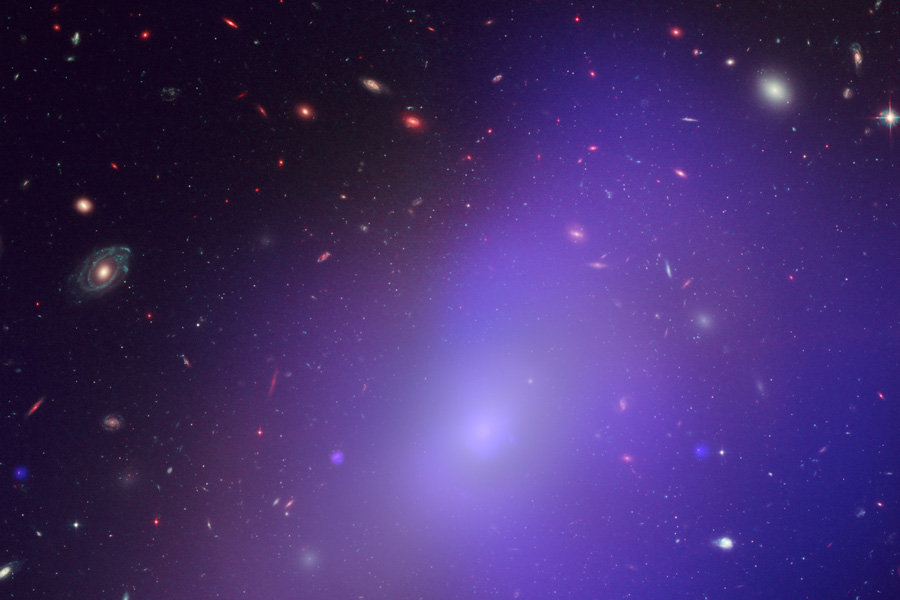NGC 1132는 매우 정적인 은하이다.
그런데 과연 이 은하는 어떻게 형성된 것일까?
타원은하인 NGC 1132는 먼지나 가스도 희박하고, 최근 새로 만들어진 별도 거의 없는 은하이다.
대부분의 타원은하들이 은하단에 포함되어 있음에 반해 NGC 1132는 에리다누스 별자리 방향에 홀로 고립되어 있는 매우 거대한 은하이다.
1조개의 별들이 뭉쳐 있는 이 흥미로운 은하의 역사를 조사하기 위해서 천문학자들은 찬드라 X선 망원경과 허블 우주망원경을 사용하여 X선 이미지와 가시광선 이미지를 각각 촬영하였다.
이 사진은 이들 각각의 이미지를 조합하여 인위적인 색깔을 입힌 사진으로서 가시광선은 하얀색으로, 그리고 특이하게 나타나고 있는 뜨거운 가스들을 의미하는 X선은 파란색으로 나타낸 것이다.
이 X선은 또한 암흑물질의 가능성이 있는 위치를 나타내는 것이기도 하다.
NGC 1132의 형성에 대한 선구적인 가설은 이 은하가 한때는 소규모였던 다수의 은하들이 합병을 거듭한 결과로 발생한 것으로 보고 있다.
NGC 1132는 3억광년 떨어진 곳에 위치하고 있어서 오늘날 우리 눈에 보이는 이 은하는 공룡들이 지구를 활보하기도 전의 모습이다.
이 은하의 뒷편 멀리로 수없이 많은 황홀한 은하들이 보이고 있다.
정보출처 : NASA - 오늘의 천체사진(2008년 2월 13일 자)
http://apod.nasa.gov/apod/ap080213.html
참고 : NGC 1132를 비롯한 은하 및 은하단에 대한 각종 포스팅은 아래 링크를 통해 확인할 수 있습니다.
- 은하 일반 : https://big-crunch.tistory.com/12346976
- 은하단 및 은하그룹 : https://big-crunch.tistory.com/12346978
- 은하 충돌 : https://big-crunch.tistory.com/12346977
원문>
Elliptical Galaxy NGC 1132
Credit:
,
,
(
), and
/
/
, et al.
Explanation: NGC 1132 is one smooth galaxy -- but how did it form? As an elliptical galaxy, NGC 1132 has little dust and gas, and few stars have formed in it recently. Although many elliptical galaxies are in clusters of galaxies, NGC 1132 appears as a large, isolated galaxy toward the constellation of the River (Eridanus). To probe the history of this intriguing trillion-star ball, astronomers imaged NGC 1132 in both visible light with the Hubble Space Telescope and X-ray light with the Chandra X-ray Observatory. In this composite false-color image, visible light is white, while the X-ray light is blue and indicates the unusual presence of very hot gas. The X-ray light also likely traces out the location of dark matter. one progenitor hypothesis is that NGC 1132 is the result of a series of galaxy mergers in what once was a small group of galaxies. NGC 1132 is over 300 million light years away, so the light we see from it today left before dinosaurs roamed the Earth. Many fascinating background galaxies can be seen far in the distance.
'3. 천문뉴스 > NASA 오늘의 천체사진' 카테고리의 다른 글
| 로 오피유키(Rho Ophiuchi) 구름의 새로운 별들 (0) | 2008.02.18 |
|---|---|
| NGC 2237 (0) | 2008.02.14 |
| 고물자리 RS별 (RS Pup) (0) | 2008.02.13 |
| 토성의 위성 에피메테우스 (0) | 2008.02.11 |
| Abell 2218 (0) | 2008.02.10 |
